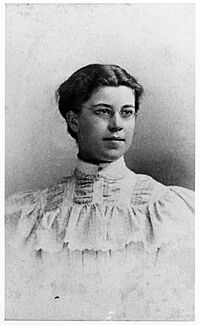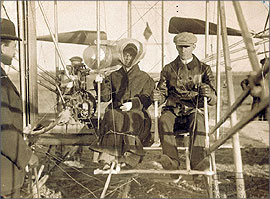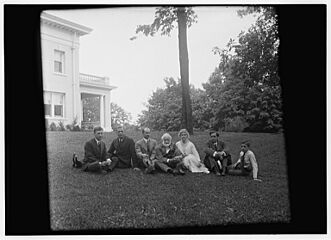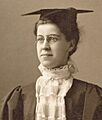Katharine Wright Haskell facts for kids
Quick facts for kids
Katharine Wright Haskell
|
|
|---|---|
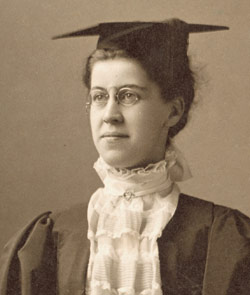
Wright in 1898 as a graduate of Oberlin College
|
|
| Born | August 19, 1874 Dayton, Ohio, US
|
| Died | March 3, 1929 (aged 54) |
| Alma mater | Oberlin College (B. A., 1898) |
| Occupation | Teacher |
| Spouse(s) |
Henry Joseph Haskell
(m. 1926–1929) |
| Parent(s) |
|
| Relatives | Reuchlin Wright (brother) Lorin Wright (brother) Wilbur Wright (brother) Otis Wright (brother) Ida Wright (brother) Orville Wright (brother) |
Katharine Wright Haskell (born August 19, 1874 – died March 3, 1929) was an American teacher. She was also a strong supporter of women's right to vote. Katharine was the younger sister of the famous aviation pioneers, Wilbur and Orville Wright.
She worked very closely with her brothers. Katharine helped manage their bicycle shop in Dayton, Ohio, when they were away. She was also a key helper for them in Europe. She managed their many letters and business matters. Katharine also helped them think through their big ideas.
Katharine had her own career as a high school teacher in Dayton. This was at a time when most middle-class American women did not work outside the home. She became well-known around the world. Katharine was an important person in the women's movement of the early 1900s. She actively worked for women's right to vote in Ohio. She was also the third woman to be a trustee (a kind of board member) at Oberlin College.
Contents
Early Life and Education
Katharine Wright was born in Dayton, Ohio, on August 19, 1874. This was exactly three years after her brother, Orville Wright. She was the youngest of five children who survived. Her parents were Bishop Milton Wright and Susan Koerner Wright.
When her mother died in 1889, Katharine was 14 years old. As the only daughter, she was expected to take on her mother's duties. During her teenage years and early adulthood, she went to school and worked as a teacher. She also managed the home she shared with her father and older brothers. Her father was a traveling preacher.
Katharine was especially close to Wilbur and Orville. She gave them important support as they worked to solve the problem of human flight. Her two oldest brothers, Reuchlin and Lorin, had already left home.
Katharine went to Central High School in Dayton. She then finished her high school studies at Oberlin Academy in 1893–94. After two years there, she went to Oberlin College. This was one of the few colleges at the time that allowed both men and women.
Katharine was the only Wright sibling to earn a college degree. She graduated in 1898, just before her twenty-fourth birthday. She was very smart, curious, and wanted to be financially independent.
After graduating, she became a teacher. She taught Latin and English at Steele High School in Dayton. She liked the work, but she earned less than the male teachers. She also got less desirable classes to teach. This unfair treatment made her dedicated to women's rights and education for life. To help with housework, Katharine hired a teenage maid, Carrie Kayler. Carrie stayed with the family for many years.
Helping Her Brothers Fly
The Wright Brothers did not have much money or government help. They used money from their bicycle shop to fund their flying experiments. After they started spending summers in Kitty Hawk, North Carolina, Katharine helped a lot.
Starting in 1901, she helped run the bicycle shop. She also packed supplies for their experiments. Katharine handled their official letters and talked to the press. As Wilbur and Orville tried to sell their Wright Flyer, they traveled to Washington, D.C., and Europe. Katharine wrote hundreds of letters to them. She kept them updated on their family businesses and news from home. She often told her unmarried brothers off if they didn't write back enough! Many of Katharine's letters can be found online.
In 1908, the brothers finally convinced the U.S. Signal Corps to let them test their Flyer. They hoped to sell it to the U.S. government at Fort Myer, Virginia. Orville was the pilot for these flights. After a week of successful flights, a terrible accident happened. On September 17, 1908, a broken propeller caused the airplane to crash. The passenger, U.S. Army Lieutenant Thomas Selfridge, died. Orville was badly hurt, with broken ribs and a broken leg.
Katharine took time off from her teaching job. She rushed to Orville's side at an Army hospital. She stayed in his room for seven weeks while he got better. She never went back to her teaching career. Orville later said he would have died without his sister's help. After the crash, Katharine helped her brothers get more time for their contract with the Signal Corps.
Katharine was not the only woman who helped the brothers. In 1910, they advertised for someone to do "plain sewing." They actually meant "plane sewing," as they needed someone to stitch the fabric for their planes. The newspaper thought it was a typo and changed it! Ida Holdgreve was hired for this job. When the Wright Company closed in 1915, she became a forewoman. She oversaw many other women sewers at the Dayton-Wright Airplane Company.
Becoming a Celebrity
Soon after Orville's accident, Wilbur asked Katharine to go to France with their recovering brother. She and Orville joined Wilbur in Pau in early 1909. Katharine was much more outgoing and charming than her shy brothers. She became very popular in Europe.
She used her good French skills to talk with European royalty and important people. These included Alfonso XIII, the King of Spain, and Prince Friedrich Wilhelm of Prussia. She also flew three times with Wilbur while they were in Pau. This made her one of the first women to fly in an airplane.
French reporters were fascinated by Katharine. They saw her as the human side of the Wright Brothers. They even made up a story that she helped Wilbur and Orville with their math. Katharine later said this was not true. The French government honored Katharine for her important role. She was named an Officier de l’Instruction Publique. This is one of France's highest academic awards. Her brothers received the famous Légion d’Honneur in 1909.
The three Wrights returned to the United States as national heroes. Back home in Dayton, Katharine took on official business roles. She briefly served on the board of the Wright Company. Orville sold the family airplane business in 1915.
At the same time, Katharine became a strong supporter of the women's right to vote movement in Ohio. She marched in a suffrage parade in Dayton on October 24, 1914. Her father, who was over 80, and brothers Orville and Lorin joined her. Katharine was a pioneering feminist. She once wrote about how she felt about living in a "man's world." She said it was like the topic of women's right to vote. Orville used to tease her about it.
Katharine traveled to Columbus to talk to state lawmakers about women's right to vote. Her efforts paid off in 1919. Ohio became the fifth state to approve the Nineteenth Amendment. This amendment gave women the right to vote across the United States.
Life After Wilbur's Death
In 1914, about two years after Wilbur died, Katharine, Orville, and Bishop Milton Wright moved. They went to Hawthorn Hill, a new mansion in Oakwood, a suburb of Dayton. Bishop Wright died three years later. Carrie Kayler and her husband, Charles Grumbach, also had an apartment in the house.
As Orville's scientific career slowed down, he relied more and more on Katharine. She continued to manage the household. She also looked after his social schedule, letters, and business meetings. She did this along with his paid secretary, Mabel Beck. Katharine also played a quiet but active role in Orville’s long struggle with the Smithsonian Institution. She helped him get proper recognition for the Wright Brothers’ invention.
Katharine often went with Orville to formal events and aviation shows. These included the International Air Races in St. Louis in 1923 and Dayton in 1924. In September 1922, they helped the Wright Aeronautical Company name the Wilbur Wright flying boat. It was designed by aviation pioneer Grover Loening. They also took part in its first flight over the Hudson River. At the launch, Katharine and Orville were photographed with Arctic explorer Vilhjalmur Stefansson.
Katharine was important in Dayton society. She was an active member of the Helen Hunt Club, a women's reading group. She was also president of the Young Women's League. She supported other community groups. She was also the driving force behind the Oberlin Alumni Association in Dayton. She served as her class secretary for many years.
In 1923, she was elected to the Oberlin College board of trustees. She served her college from 1924 until her death in 1929. She was only the third female trustee in Oberlin's history. She had a strong influence on things like hiring teachers and presidents, building plans, and academic freedom.
Marriage and Later Life
Over the years, Katharine stayed in touch with Henry (Harry) J. Haskell. He was a newspaper editor and a close friend from her college days. He had once helped her with math. Haskell lived in Kansas City, Missouri. Katharine and Orville visited him there several times. Their older brother Reuchlin and his family also lived in Kansas City.
Haskell was one of a few important journalists who helped the Wright brothers in their disagreement with the Smithsonian. After his wife died in 1923, he and Katharine started a long-distance romance. They mostly communicated through letters.
Katharine was worried about how Orville would react to their marriage. Her secret fiancé and Orville had been friends for a long time. Her fears came true when Haskell finally told Orville the news. Orville was very upset and almost stopped talking to his sister.
After waiting for over a year, Katharine finally married Harry on November 20, 1926. It was a small private ceremony at the Oberlin home of their friend Professor Louis Lord. Orville believed his sister had broken a family promise to stay unmarried. He refused to go to the wedding and stopped all contact with her. Other family members were more supportive. One of Katharine's nieces even attended the ceremony.
Katharine left Hawthorn Hill secretly and sadly. She made her new home with Harry in Kansas City. They had a happy marriage. However, she continued to feel sad about her broken relationship with Orville.
In early 1929, Katharine got pneumonia. This was as the Haskells were getting ready for their delayed honeymoon in Europe. When Orville found out, he still refused to contact her. Their brother Lorin, who had supported Katharine's marriage, convinced Orville to visit her. Orville was at her bedside when she died on March 3, 1929, at age 54.
Legacy
After her death, Katharine's fellow Oberlin trustees called her "a world figure." In 1931, Haskell gave a fountain to the college in her memory. It has a copy of a bronze sculpture by Verrocchio. It stands near the entrance to the Allen Memorial Art Museum. This is close to the college's Wilbur and Orville Wright Laboratory of Physics.
For many years, historians and writers about the Wright Brothers did not focus on Katharine's role. They often ignored or downplayed her importance as part of the family team. Only with more interest in women's history in the late 1900s did this change. New letters and documents were found. Then, Katharine began to be recognized as an unsung partner to Wilbur and Orville. She was also seen as an important figure in the women's movement.
Books like Richard Maurer's The Wright Sister and Ian Mackersey's The Wright Brothers (both from 2003) helped. David McCullough's The Wright Brothers (2015) also helped. These books show the ongoing effort to give Katharine Wright Haskell her rightful place in the Wright brothers’ story. In 2017, Henry J. Haskell's grandson published Maiden Flight. This book is about her marriage later in life. He also made a three-part podcast called In Her Own Wright.
Plays and an opera have also been made about Katharine's life. In 2022, the Smithsonian Institution's National Air and Space Museum opened a new Wright Brothers exhibit. In this exhibit, Katharine's important role is highlighted.
Images for kids
-
Wright in 1898 as a graduate of Oberlin College


